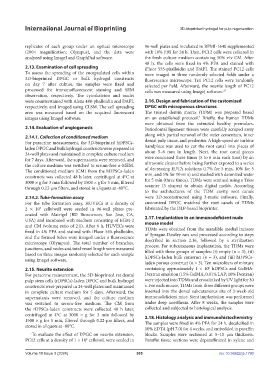Page 313 - IJB-10-3
P. 313
International Journal of Bioprinting 3D-bioprinted hydrogel for pulp regeneration
replicates of each group under an optical microscope 96-well plates and incubated in RPMI-1640 supplemented
(200× magnification; Olympus), and the data were with 10% FBS for 24 h. Then, PC12 cells were cultured in
analyzed using ImageJ and GraphPad software. the fresh culture medium containing 50% v/v CM. After
48 h, the cells were fixed in 4% PFA and stained with
2.13. Examination of cell spreading iFluor 555-phalloidin and DAPI. The stained PC12 cells
To assess the spreading of the encapsulated cells within were imaged in three randomly selected fields under a
3D-bioprinted DPGC or bulk hydrogel constructs fluorescence microscope. Ten PC12 cells were randomly
on day 7 after culture, the samples were fixed and selected per field. Afterward, the neurite length of PC12
processed for immunofluorescent staining and SEM cells was measured using ImageJ software. 27
observation, respectively. The cytoskeleton and nuclei
were counterstained with Alexa 488-phalloidin and DAPI, 2.16. Design and fabrication of the customized
respectively, and imaged using CLSM. The cell spreading DPGC with microporous structures
area was measured based on the acquired fluorescent The treated dentin matrix (TDM) was prepared based
images using ImageJ software. on an established protocol. Briefly, the human TDMs
7
were obtained from the extracted healthy premolars.
2.14. Evaluation of angiogenesis Periodontal ligament tissues were carefully scraped away
2.14.1. Collection of conditioned medium along with partial removal of the outer cementum, inner
For paracrine measurement, the 3D-bioprinted hDPSCs- dental pulp tissue, and predentin. A high-speed air turbine
laden DPGC and bulk hydrogel constructs were prepared in handpiece was used to cut the root canal into pieces of
24-well plates and maintained in complete culture medium about 5–6 mm in length. Next, the root canal pieces
for 7 days. Afterward, the supernatants were removed, and were concussed three times (5 to 6 min each time) by an
the culture medium was switched to serum-free α-MEM. ultrasonic cleaner before being further exposed to a series
The conditioned medium (CM) from the hDPSCs-laden of decreasing EDTA solutions (17% for 5 min, 10% for 5
constructs was collected 48 h later, centrifuged at 4°C at min, and 5% for 10 min) and washed with deionized water
3000 × g for 3 min followed by 1500 × g for 5 min, filtered for 5 min (three times). TDMs were scanned using a Trios
through 0.22-μm filters, and stored in aliquots at -80°C. scanner (3 shapes) to obtain digital molds. According
to the architectures of the TDM cavity, root canals
2.14.2. Tube-formation assay were 3D-reconstructed using 3-matic software. Finally,
For the tube formation assay, HUVECs at a density of customized DPGC matched the root canals of TDMs
2 × 10 cells/well were seeded in 96-well plates pre- fabricated by the DLP-based bioprinter.
4
coated with Matrigel (BD Biosciences, San Jose, CA,
USA) and incubated with medium consisting of EGM-2 2.17. Implantation in an immunodeficient nude
and CM (volume ratio of 2:1). After 6 h, HUVECs were mouse model
fixed in 4% PFA and stained with iFluor 555-phalloidin, TDMs were obtained from the mandible medial incisors
and the formed tubes were imaged under a fluorescence of Sprague-Dawley rats and processed according to steps
microscope (Olympus). The total number of branches, described in section 2.16, followed by a sterilization
process. For subcutaneous implantation, the TDMs were
junctions, and nodes and total vessel length were measured filled with three groups of samples: (i) empty (n = 3), (ii)
based on three images randomly selected for each sample hDPSCs-laden bulk construct (n = 3), and (iii) hDPSCs-
using ImageJ software.
laden porous construct (n = 3). Ten microliters of mixture
6
2.15. Neurite extension containing approximately 1 × 10 hDPSCs and GelMA-
For paracrine measurement, the 3D-bioprinted rat dental Dextran emulsion (15% GelMA, 0.01% LAP; 10% Dextran)
pulp stem cells (rDPSCs)-laden DPGC and bulk hydrogel were injected into TDMs and crosslinked by UV light for 30
constructs were prepared in 24-well plates and maintained s. For each mouse, TDMs from three different groups were
in complete culture medium for 5 days. Afterward, the inserted into the dorsal subcutaneous site of 3-week-old
supernatants were removed, and the culture medium immunodeficient mice. Stent implantation was performed
was switched to serum-free medium. The CM from under deep anesthesia. After 8 weeks, the samples were
the rDPSCs-laden constructs were collected 48 h later, collected and subjected to histological analysis.
centrifuged at 4°C at 3000 × g for 3 min followed by 2.18. Histology analysis and immunohistochemistry
1500 × g for 5 min, filtered through 0.22-μm filters, and The samples were fixed in 4% PFA for 24 h, decalcified in
stored in aliquots at -80°C.
10% EDTA (pH 7.0) for 4 weeks, and embedded in paraffin
To evaluate the effect of DPGC on neurite extension, blocks. Samples were sectioned at 5–10 μm thickness.
PC12 cells at a density of 1 × 10 cells/mL were seeded in Paraffin tissue sections were deparaffinized in xylene and
4
Volume 10 Issue 3 (2024) 305 doi: 10.36922/ijb.1790

